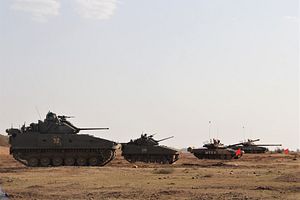On April 13, the Indian Army and the Singapore Army concluded the latest iteration of their bilateral armor training exercise, named Bold Kurukshetra. The exercise began on April 2 and concluded on April 13. In total, 270 troops from both countries participated. This year’s exercise involved integrated live-fire drills.
India and Singapore enjoy a close military relationship that includes various aspects, including high-level visits, policy dialogues, courses, and other professional exchanges. Both sides have been looking to further expand this aspect of the relationship as broader patterns of collaboration evolve in the wider Indo-Pacific, with recent examples including the inking of a new naval pact and the Indian Navy’s access to Changi Naval base in Singapore.
The army component of the bilateral defense relationship includes various arrangements, including those that allow the Singaporean Army to train in India – part of a series of deals with a few key countries and services that afford the city-state much-needed space to train abroad that it does not have at home. In terms of exercises, the two armies conduct several drills, and among these is bilateral armor exercise Exercise Bold Kurukshetra.
“The 12th edition of joint military exercise between India and Singapore, BOLD KURUKSHETRA 2019, culminated on 11 April 2019 after an impressive closing ceremony held at Babina Military Station,” an Indian Army statement released by Lt. Col. Mohit Vaishnava noted. The exercise involved the Singapore Army’s Infantry Fighting Vehicles and Indian Army Main Battle Tanks.
“The four day long joint training focused on developing interoperability and conduct of joint tactical operations in mechanized warfare,” the Indian Army statement noted. “The troops learnt about each other’s organizations and best practices being followed in combat.”
A statement released by the Singaporean Ministry of Defense delved into the exercise in more detail, underscoring that the “highlight of this year’s exercise was the integrated live-firing involving the Singapore Army’s Infantry Fighting Vehicles and IA’s Main Battle Tanks and Infantry Fighting Vehicles.”
“As part of the exercise, the two armies participated in integrated maneuvers, exercise planning and training,” the statement added.
“The training here has allowed our armor units to hone their operational skills and competencies in a realistic live-firing environment. More importantly, the opportunity to work together with the Indian Army in professional exchanges and joint training has enhanced our mutual understanding and cooperation,” Commander of the 8th Singapore Armored Brigade Senior Lieutenant Colonel Dean Yik said in a statement.
The Bold Kurukshetra exercise was constituted under a military-to-military agreement between the two sides, known as the Bilateral Agreement for Joint Army Training and Exercises. The two countries renewed that agreement last November, during Singaporean Defense Minister Ng Eng Hen’s talks with his Indian counterpart Nirmala Sitharaman in India.
Defense and security cooperation between India and Singapore has been growing in recent years. In 2018, during his keynote address to a Singapore-based international security conference, Indian Prime Minister Narendra Modi underscored that it was with Singapore that India had its “longest uninterrupted naval exercise, which is in its 25th year now.”
That exercise — known as SIMBEX — last occurred last fall in the Andaman Sea and the Bay of Bengal. It involved the largest contingent from both sides participating in its history, with 30 aircraft, ships, and submarines participated in what marked the 25th anniversary of SIMBEX.
Singapore has supported India playing a greater role in the Indo-Pacific region. During his trip to India last November, Ng noted that “Singapore is very supportive of India’s vital security of the Indo-Pacific region and we share common security interests geographically that is the Strait of Malacca and the Andaman Sea, which is really a continuous body of water that is a critical Sea Lines of Communication.”
































